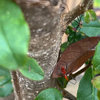Long term flea beetle control
alabamanicole
13 years ago
Related Stories

GARDENING GUIDESTexas Gardener: What to Do in July
Beat the heat with sun-loving blooms, pest control, good lawn care and sun protection. Pick up the pace for planting and planning
Full Story
GARDENING GUIDESLessons in the Rewards of Selfless Gardening
Let go of gardening for your own vision and watch the garden’s own true vision come forth
Full Story
GARDENING GUIDESTree Care: Common Tree Diseases and What to Do About Them
Learn to recognize trees that may be affected by diseases or pests so you can quickly take action
Full Story
MOST POPULAR10 Strategies for Keeping Surfaces Clutter-Free
The universe wants your coffee table to become a clutter magnet — but you can fight back
Full Story
PETSA Romp Through Pet-Friendly Materials
Deceptively durable, these stylish flooring materials and fabrics let you give Fluffy the run of the house
Full Story
GARDENING AND LANDSCAPINGBid Bad Garden Bugs Goodbye and Usher In the Good
Give ants their marching orders and send mosquitoes moseying, while creating a garden that draws pollinators and helpful eaters
Full Story
MOST POPULARWhy We Love Midcentury Modern Design
There's a method to all this 'Mad Men'-ness — just look to psychology, tough times and, believe it or not, Apple
Full Story
DECORATING GUIDESBudget Decorator: Let’s Go Thrifting
Dip into the treasure trove of secondhand pieces for decor that shows your resourcefulness as much as your personality
Full Story
DECORATING GUIDESHow to Choose an Awesome Area Rug No Matter What Your Space
High use, a low door, kids and pets running amok — whatever your area endures, this insight will help you find the right rug for it
Full Story







Dan _Staley (5b Sunset 2B AHS 7)
Michael
Related Professionals
Danbury Landscape Architects & Landscape Designers · Harrison Landscape Architects & Landscape Designers · Clark Landscape Contractors · Lady Lake Landscape Contractors · Lebanon Landscape Contractors · Lemay Landscape Contractors · Plainview Landscape Contractors · Wilton Landscape Contractors · Eastlake Landscape Contractors · Palos Heights Landscape Contractors · Ashland Decks, Patios & Outdoor Enclosures · Fort Pierce Decks, Patios & Outdoor Enclosures · Glasgow Decks, Patios & Outdoor Enclosures · La Palma Decks, Patios & Outdoor Enclosures · Pittsburgh Decks, Patios & Outdoor EnclosuresKimmsr
alabamanicoleOriginal Author
peter_6
Michael
alabamanicoleOriginal Author
Dan _Staley (5b Sunset 2B AHS 7)
Kimmsr
alabamanicoleOriginal Author
novice_2009
novice_2009
alabamanicoleOriginal Author
Kimmsr
peter_6
alabamanicoleOriginal Author
Michael
ladyofthewoods
idaho_gardener
alabamanicoleOriginal Author
Michael
alabamanicoleOriginal Author